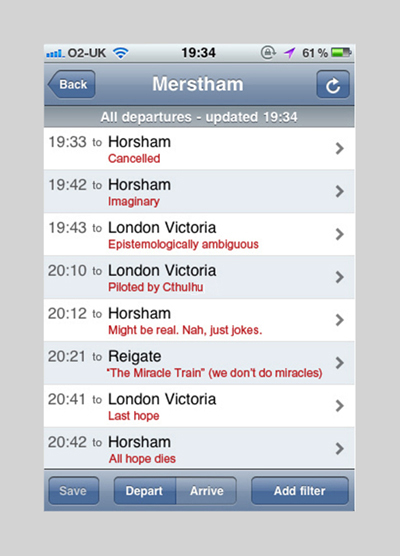
For a long time, I’ve shied away from writing here about personal data. Or even thinking that deeply about it. The nature of identity, yes. The usefulnesss of data, yes. Personal data, no. Why?
Not because it isn’t fascinating, or important. Mainly because it’s so…damn…nebulous. And difficult. Time to get over that, I think. Very significant things are happening in this area, and we all need to raise our game in how we understand and engage with the concepts involved.
As I’ve surmised before, the only things that are really different in the Internet age are the ease with which information can be found, and the ease with which it can be stored.
Two things, really. That’s all.
The first embraces everything around indexing, cross-referencing, labelling, structure and searching. The latter takes us into the territory of copying (and of course copyright), archiving, and the general issue of persistence.
And when we look at personal data in that context, there is an immediacy–and potential toxicity–in what emerges.
We saw early rumblings of this long before the Internet, of course, when computers were first used for the mass processing of information about people. Things could be done with databases that simply weren’t possible with big paper ledgers.
We created Data Protection legislation which attempted to put reins on the ability to make free use of some types of information. Gathering stuff about people, from the basic facts of who and where, to how to contact them, who they were connected to, and what their tastes and preferences were. Pure gold, used in the right (or wrong) ways.
Data Protection set out some pretty sound, but general, principles. The overarching one being that the purpose to which data could be put should always be made clear to whoever provides it, at the time of providing. Lots of other stuff about processing, storage, where and how long, and so forth–but that issue of consent always seemed the most important, to me.
And we scratched about a bit to actually try and define what we meant by “personal data”. Some things were easy. Names. Addresses and phone numbers. They’re just obvious.
But what about our tastes? Our buying history? The movements of our mobile phone from cell to cell? A journey we took? As one takes informational side-steps away from the individual, the obviousness diminishes, but if you can make meaningful connections back to the person…
…and remember the first thing that the Internet really changes?
Being able to make those tenuous links between blocks of information into something really substantive.
And the second thing? That information and those links are now permanent. You can’t delete them, once they’re there.
All those things that databases couldn’t previously do, because they all conformed to different standards, and weren’t connected together? They can now. Things can be done via the Internet that simply weren’t possible with just the databases.
Bit by bit, it’s been possible to build up the most humongous repositories about people. Maybe entirely within the law, maybe in other ways as well. Maybe with explicit and informed consent all the way down the line. And maybe not.
Who’s to know? We find strange things going on with data that we provide in order to use one or other service–or even to exercise our democratic rights. Didn’t it ever strike you as slightly weird that the electoral roll could be sold on for commercial purposes? (Much more on the electoral roll in another post coming soon.Update: now here)
We have big companies that have built successful businesses just like this: perhaps using aggregated personal information for credit referencing, perhaps to sell to marketeers to give them a better understanding of demographics.
The genie is very much out of the bottle. Your rights to see the information that a particular company holds on you may exist, but you have to have a fair idea of which company to ask in the first place. Can you ever see the full picture of what others know about you?
Of course not.
And it’s unreasonable to suggest that we’ll ever be able to do that. Instances of data multiply more rapidly than does our capability to track them. (There must be a Law of Internet Entropy out there that says something like that. If not, I just invented one.)
(As an aside, a dear friend once uttered the memorable line “somewhere out there, there’s a database with your dick size on it”. That was in 1989.)
So what can we do?
Realistically, all that’s available to us are firebreaks and friction.
We can’t get that genie back in the bottle, but we can slow it down a bit, and find ways to mitigate the impacts.
Do we need an updated definition of personal data? It’s MUCH harder than it seems at first glance to create one. The best I can find at the moment in terms of an “official” position is here.
And it’s clumsier than you think. Essentially, it’s a list of ever-widening filters that assess whether a particular piece of information can be connected to a specific individual. Culminating in the rather wonderful catch-all of the final category:
8. Does the data impact or have the potential to impact on an individual, whether in a personal, family, business or professional capacity?
Yes The data is ‘personal data’ for the purposes of the DPA.
No The data is unlikely to be ‘personal data’.
Even though the data is not usually processed by the data controller to provide information about an individual, if there is a reasonable chance that the data will be processed for that purpose, the data will be personal data.
That’s pretty general, no? In fact, going by that, an awful lot of things are now personal data. I really like the emphasis it puts on the outcome of the data use, not attempting to over-define things like form and structure.
I’d go as far to say we should probably throw away that big long document, and just run with this definition:
Personal data is information that affects you when it’s used. Either directly, or through being linked to other information using technologies that exist now, or may exist in the future.
Broad enough? ;)
(So my beloved photos: they’re personal data. I take them with a camera that has a unique number, held in metadata in the picture file. That provides a way to link all the pictures it takes together, and then, through the various accounts I put them in online, back to me. Think how many other trails you leave…)
But again, all we really have are firebreaks, and friction. There’s a sort of reverse entropy at work. Unlike almost every other instance of entropy–where things get more chaotic over time (china plates get broken, they never put themselves back together again)–personal information is, relentlessly, only going to get more linked. More aggregated. More pervasive. More permanent.
(So, maybe I just invented The Law of Reverse Internet Entropy as well? Not bad going for one post…)
And if someone tells you that big blocks of personal data can be “de-anonymised”, be very sceptical indeed. (You can read some wise thoughts on the issues involved here and elsewhere on that blog.)
We can undertake some pretty noble fire-breaking: like ensuring the state doesn’t become the source of a global universal identifier for you. And we will certainly see more developments around multiple personas: compartments of your life associated with particular tasks, contexts, or connections. I think we’ll have to. (The concept of federated identity helps here, but that’s too much to go into for this post. Read more thoughts from the team working up these concepts for government.)
And we’ll adjust. Society has seen some pretty dramatic upheavals. Often associated with a new technology, or philosophy. If we adjust our societal norms faster than the upheaval, we don’t notice. If we’re slower to change, it’s painful. For a bit.
But we get through. We adapt. And we change. Always.









